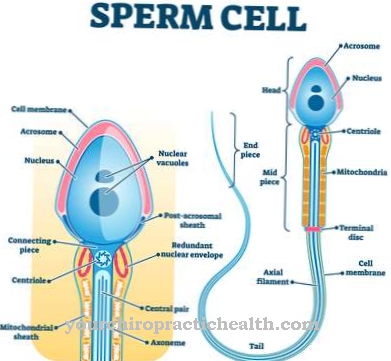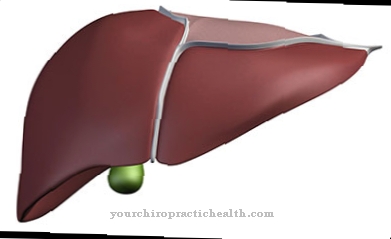Hemarthrosis is the medical name for one Bruise in the knee. As a result of a knee injury, blood accumulates in the joint.
What is hemarthrosis?

© Photographee.eu - stock.adobe.com
Under the term Hemarthrosis is called a bruise in the knee. The term is to be distinguished from the term hematoma, which is a collection of blood in all parts of the body. A bruise is the leakage of blood from an injured blood vessel.
Subsequently, the blood is deposited in a body cavity or in tissue. The bruise becomes visible as a bruise that forms on the knee in the event of hemarthrosis. The blood can no longer be removed from the veins. Therefore, the knee fills with blood, which leads to its thickening. As the process progresses, the bruise takes on a yellowish color and then disappears again.
causes
Hemarthrosis can arise from different causes. In most cases, the bruise in the knee is caused by injuries to the joint structures. Sometimes there are also long-term consequences from wear and tear, chronic inappropriate strain or sports injuries.
Some sports are considered to be particularly risky for the development of hemarthrosis. This primarily includes football and skiing. The same applies to other sports where knees and legs are exposed to heavy loads. There is also an increased risk of rotational trauma in the knee. If the lower leg twists too much towards the thigh, there is a risk of injury to the menisci, collateral ligaments or cruciate ligaments.
The range of injuries ranges from a stretched ligament to a torn ligament. The jerky injuries often also affect the blood vessels that run through the knee. This in turn leads to a bruise in the adjacent tissue and the knee cavities.
It is not uncommon for hemarthrosis to be caused by external influences in which the kneecap (patella) or the bones are involved. Mostly serious falls are responsible for this. A hemarthrosis can result from a slight bruise as well as from a bone fracture.
Sometimes surgical interventions on the knee are also responsible for the formation of hemarthrosis. The body classifies the operation as an injury. Even the use of certain drugs can be the cause of hemarthrosis. If this is the case, the attending physician must prescribe a different medication. A specific cause of a bruise in the knee cannot be found in every case. The hemarthrosis shows up without any previous injury.
Symptoms, ailments & signs
The symptoms of hemarthrosis depend on the extent of the bruise. If the bruise is only minor, those affected only suffer from tenderness and slight swelling. A typical feature of hemarthrosis is a bluish discoloration of the knee. Initially, the injured area takes on a reddish discoloration, which later turns into blue and yellow.
If the hemarthrosis is extensive, this is often noticeable as permanent and stronger pain. Doctors also speak of tension pain. It is caused by the swelling caused by the bruise spreading. In addition, there are restricted movements of the knee.
Diagnosis & course of disease
If there is a hemarthrosis in the knee, a medical examination is recommended. There is a risk of further injuries to the joint or bones and severe pain. The doctor has the patient describe the course of the injury. This is often enough to make the correct diagnosis.
If the hemarthrosis is deeper, a sonography (ultrasound examination) may be necessary. The course of a hemarthrosis depends on how quickly therapy is started. So the lesions can usually be kept small with early treatment. Without rapid therapy, there is a risk of permanent restriction of movement and damage to the cartilage.
Complications
The symptoms and complications of hemarthrosis depend heavily on the severity of the bruise and its cause, although in most cases it is an accident. Usually there is swelling and the affected person suffers from pain. The pain usually occurs in the form of tenderness, but can also occur as pain at rest and lead to sleep problems.
The affected area turns red or blue and can also pulsate. If the hemarthrosis is not treated, the pain usually does not go away on its own and leads to a decrease in the patient's quality of life. Furthermore, there are also restrictions in movement, which can often lead to psychological complaints. The everyday life of the person affected is made more difficult and normal activities can no longer be carried out without further ado.
In most cases, no direct treatment of the hemarthrosis is necessary and it will go away on its own. If it was a serious accident, an examination by a doctor may be necessary. However, there are no particular complications or serious complaints. The life expectancy is also not influenced by hemarthrosis.
When should you go to the doctor?
Hemarthrosis is usually harmless and disappears by itself after a few days. Medical advice is needed if the bruise persists for more than a week. If there are severe pain or other symptoms, the hemarthrosis must always be examined. The bruise may pinch a nerve or press on the surrounding tissue. Larger effusions can also cause severe tension pain and restricted mobility, which require the use of painkillers and anti-inflammatory drugs.
Furthermore, you should see a doctor with hemarthrosis if there are additional injuries or if you have repeatedly bruised. If the hemarthrosis occurs after a surgical procedure on the knee, the responsible doctor must be informed. Patients with chronic joint diseases or protracted sports injuries should also speak to their doctor and have their complaints clarified. Other contact persons are the orthopedist, a sports doctor or a specialist in joint diseases. If the symptoms are severe, a visit to the hospital is indicated.
Doctors & therapists in your area
Treatment & Therapy
In most people, hemarthrosis goes away on its own, which only takes a few days. The leaked blood coagulates and the organism breaks it down again with the help of enzymes. Due to the different breakdown products, there is alternating discoloration in red, blue and yellow.
In order to counteract swelling of the knee, the patient should cool the joint immediately after the accident. In this way, the blood vessels contract and the bleeding decreases or even comes to a complete stop. Since the bruise in the knee cannot spread any further, the swelling also decreases.
The doctor decides on further therapy. If the cause of the hemarthrosis is corrected, no further treatment is usually required. The bruise in the knee will completely recede after two to three weeks. A special hematoma tape can be applied to the knee to treat the pain, which speeds up the healing process.
Sometimes it is also possible that the hemarthrosis cannot heal on its own. In such cases, a joint puncture is performed. The doctor pricks the joint with a thin needle and sucks off the blood. Usually the patient will feel an immediate improvement. An arthroscopy (knee joint mirroring) can also be performed.
You can find your medication here
➔ Drugs for wound treatment and injuriesprevention
Exercise caution in order to avoid hemarthrosis. The knee should be protected from falls with special protectors.
Aftercare
Follow-up care aims to prevent symptoms from recurring. This is well known from cancer. Scheduled follow-up examinations are intended to detect a tumor in its early stages and thus enable the best possible treatment. On the other hand, aftercare for hemarthrosis consists of preventive measures.
This is intended to avoid the causes that trigger the disease. Specifically, this means: overexertion should be avoided during sporting activities such as football and skiing. The attending physician informs about the dangers as part of the initial diagnosis. However, the implementation of the behavioral recommendations is the responsibility of the patient.
If the course is unfavorable, hemarthrosis can lead to long-term treatment. This is due to lasting damage. The typical complaints then include restricted mobility and pain. The medical help offered then includes physiotherapy. Scheduled follow-up examinations, which document the progress of the disease, are agreed individually.
Their rhythm depends on the complaint situation. Sonography is suitable for determining this. Hemarthrosis can also be depicted in deep places. Furthermore, the symptoms presented by the patient allow a diagnosis. In any case, aftercare aims to prevent the transition to osteoarthritis. This complication can cause further instabilities.
You can do that yourself
After an accident, the affected knee must first be cooled and immobilized. With the help of so-called hematoma tapes, which are stuck to the affected skin, the swelling at the bruise can be further reduced. If the pain subsides quickly, the knee joint must be carefully observed for a few hours. If severe pain occurs or movement restrictions and other complaints occur, medical treatment is required.
Depending on which injury is diagnosed, various self-help measures can then be taken. Ligament stretching and torn ligaments require medical therapy. There is not much that the person affected can do here, except to protect the knee and take advantage of the routine examinations in the doctor's office. Bruises usually heal on their own after medical treatment. It is sufficient to cool the hemarthrosis and to avoid putting any strain on the affected knee. With quark packs and other home remedies, healing can be accelerated under certain circumstances.
An operation-related hemarthrosis must be presented to the responsible doctor immediately. After a procedure, the knee should be closely monitored to avoid further bruising and further complications.

.jpg)




.jpg)

















.jpg)



